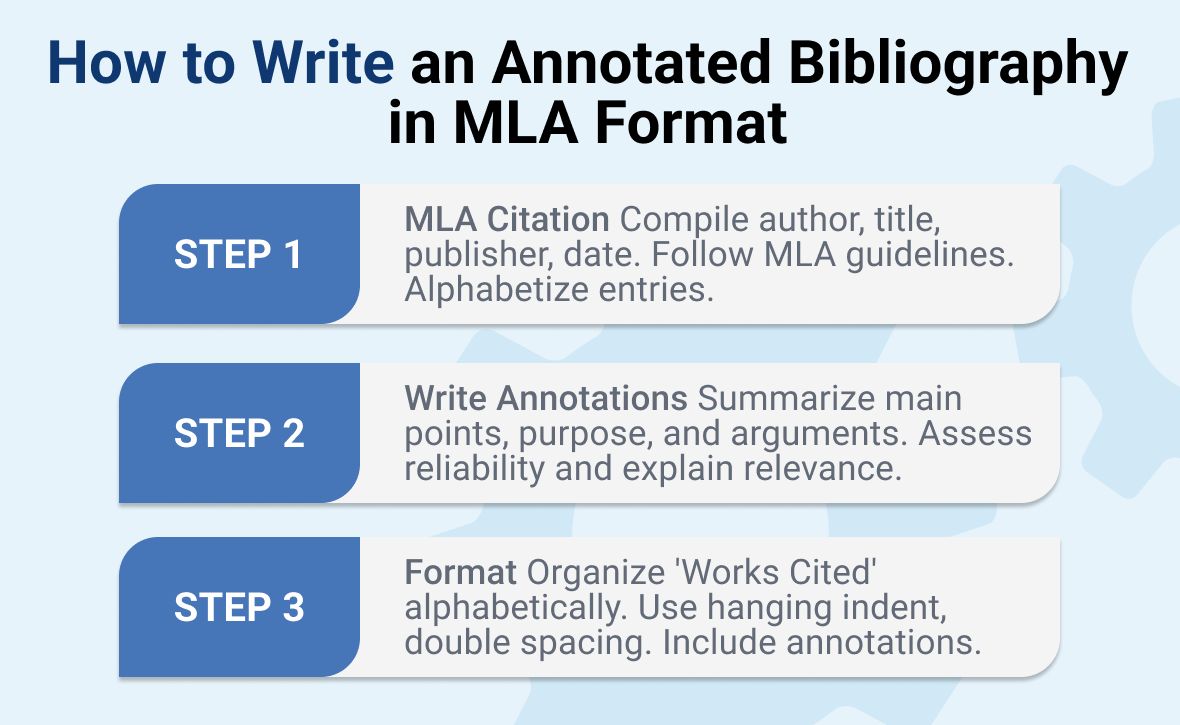.png)
How to Write an Annotated Bibliography in MLA Format
Greetings, academic enthusiasts! Struggling to figure out how to write an MLA annotated bibliography assigned by your professor? It happens to the best of us. Take a moment to breathe because you're in the right place!
Did you know that the Modern Language Association (MLA) guidelines, established in 1883, serve as a foundational pillar in academic writing? Whether you're a seasoned researcher or a newcomer to the world of citations, our comprehensive guide walks you through everything you need to know to create an annotated bibliography in MLA format. Let me be your annotated bibliography writer and break it down step by step – no fuss, no frills.
What Is an Annotated Bibliography in MLA Format
An MLA annotated bibliography is essentially a list of sources, such as books, articles, or other documents, accompanied by a brief description or annotation. Each entry in the bibliography includes the full citation of the source in MLA style, comprising the author's name, title of the source, publication details, and other relevant information.
Now, what sets an annotated bibliography apart is the addition of concise annotations after each citation. These annotations serve to provide a brief summary, evaluation, and reflection on the source's content. Typically, an annotation ranges from 100 to 200 words, but this can vary based on the instructor's guidelines.
The summary part of the annotation outlines the main ideas and key points of the source, giving the reader a snapshot of its content. The evaluation aspect critically assesses the source, commenting on its reliability, relevance, and overall quality. Lastly, the reflection component briefly discusses how the source contributes to the researcher's own work or the broader field of study.

How Does an MLA Annotated Bibliography Differ From Other Styles
Distinguishing an MLA annotated bibliography from other citation styles involves examining specific formatting conventions and the content of the annotations. While the core purpose of an annotated bibliography remains consistent across styles – offering a comprehensive list of sources with additional insights – the nuances in formatting and content set MLA apart.
- Formatting Consistency: In an MLA annotated bibliography format, entries are organized alphabetically by the author's last name, mirroring the structure of an MLA Works Cited page. The entire bibliography is double-spaced, and a hanging indent is used for annotations. This adherence to specific formatting guidelines ensures consistency and clarity.
- Complete Citation: It provides a full and accurate citation for each source. This includes the author's name, the title of the source, publication details, and other relevant information presented in a standardized manner.
- Concise Annotations: Annotations in an MLA-style bibliography are typically concise, ranging from 100 to 200 words. This brevity encourages a focused and succinct summary of the source's content, evaluation of its reliability and relevance, and reflection on its contribution to the research.
- Paragraph Format: Annotations are generally written in paragraph form, offering a cohesive and structured overview of the source. The paragraph format facilitates a seamless integration of summary, evaluation, and reflection within each annotation.
- Specific Content Emphasis: They prioritize summarizing the main ideas and key points of the source, evaluating its credibility and relevance, and reflecting on its significance to the researcher's work or the broader field of study. This emphasis aligns with the purpose of aiding researchers in their evaluation and application of the cited materials.
MLA Annotated Bibliography Example
Now that you understand how to put together an annotated bibliography following MLA guidelines let's take a practical look. We'll use an example to break down the specific details. This walkthrough will help you get a clear picture of how to implement these guidelines when you're tasked with 'write my annotated bibliography' in your academic journey.
.png)
Tips for MLA Annotated Bibliography
- Ensure each annotation emphasizes how the source directly contributes to your research.
- Provide a brief but insightful critique of the source's reliability, methodology, and overall credibility.
- Consider how each source fits into your research puzzle before writing annotations.
- Choose dynamic words to convey your evaluation, making annotations impactful and concise.
- Strive for a balance in annotation length—neither too brief to lack substance nor too lengthy to lose reader interest.
- Take the time to review and refine your annotations, ensuring they are clear, error-free, and effectively convey the essence of each source.
How to Write an Annotated Bibliography in MLA Format in 3 Steps
Trying to successfully create an MLA annotated bibliography format? It's crucial to follow the rules set by the Modern Language Association. This guide walks you through creating one in three steps, making sure your citations are spot-on and your MLA Annotated Bibliography provides useful information.

Step 1: Create Your Citation in MLA
In this step of creating an MLA citation annotated bibliography, compile the bibliographic information for each source. Include the author's name, title of the work, publication information (such as the name of the publisher and publication date), and any other relevant details. Arrange the entries alphabetically by the author's last name. Ensure that you follow the specific MLA guidelines for formatting each element of the citation.
Step 2: Create the MLA Annotations
At this point, you already know what is an annotation in a bibliography. So, providing a concise summary of the source's main points, purpose, and arguments should be no issue. Mention the intended audience and the relevance of the source to your research. Additionally, evaluate the reliability and credibility of the source. The annotation should offer insights into why the source is valuable for your research project.
Step 3: Finalize Formatting
In the final step, organize your annotated bibliography according to the guidelines. Create a separate page titled 'Works Cited,' and list your sources in alphabetical order by the author's last name. Include the annotated entries beneath each citation. Follow these guidelines for formatting:
- Use a hanging indent for each entry, with the first line flush left and subsequent lines indented.
- Maintain double spacing throughout the entire bibliography.
- Alphabetize the entries by the author's last name.
- Include your annotations directly beneath each citation, indented and following the same double-spacing.
Example of MLA Annotated Bibliography
Time to put the theory into practice! We're about to walk through an example that brings those guidelines to life. Get ready to see the nuts and bolts of solid work in action with some extra tips for creating effective annotated bibliographies!
.png)
- Relevance Rule: Prioritize sources directly relevant to your research, ensuring each annotated entry serves a specific purpose.
- Diversify Source Types: Include a mix of books, articles, and other source types to offer a comprehensive view of your research topic.
- Chronological Order: Consider organizing your bibliography chronologically if it enhances the understanding of the historical development of your topic.
- Scope in Annotations: Tailor annotations to include the source's scope—whether it's broad background information or a detailed analysis.
- Synthesize Information: Aim for annotations that go beyond summarizing. Synthesize information to demonstrate how sources connect and contribute to your overall research.
- Future Use Reflection: Reflect briefly on how each source might be applied in your research, indicating its potential contributions to future work.
Final Thoughts on MLA Annotated Bibliography
Don't worry if the MLA annotated bibliographies feel a bit overwhelming; you've got the skills. With your research and learning about what is MLA format, you're practically an expert. Now, it's time to showcase those skills and explain why each source fits perfectly into your paper!
FAQ
How Do You MLA Format an Annotated Bibliography?
Formatting an annotated bibliography in MLA involves creating accurate citations for each source, considering elements like the author's name, source title, and publication details. Following this, you'll need to craft concise annotations that summarize the source's main points, evaluate its reliability and relevance, and reflect on how it contributes to your research. Lastly, ensure your entire bibliography is organized alphabetically, with annotations having a hanging indent, all in line with MLA guidelines for consistency in font and spacing.
What Are the 3 Parts of an Annotated Bibliography?
An annotated bibliography comprises three essential parts:
- Citation: The bibliographic information for each source is formatted according to the designated citation style (e.g., MLA, APA).
- Summary: A concise summary of the source's main ideas, key points, and arguments.
- Evaluation and Reflection: A critical evaluation of the source's reliability, relevance, and overall quality, followed by a brief reflection on its significance to your research or the broader field of study.
What Is the Spacing for an Annotated Bibliography in MLA Format?
In MLA format, the spacing for an annotated bibliography should be double-spaced. This applies to both the entries within the bibliography and the annotations themselves. Double spacing ensures readability and conforms to the general formatting guidelines for MLA-style papers.
What does an MLA annotated bibliography look like?
It typically appears as a list of sources, organized alphabetically by the author's last name. Each entry includes a proper MLA citation, followed by a concise annotation. The annotation is written in paragraph form, offering a summary of the source's main points, an evaluation of its reliability and relevance, and a brief reflection on its contribution to the research or broader field of study. The entire bibliography, including citations and annotations, is double-spaced.
What Is MLA Format for Citations?
Citations typically include the following elements:
- Author's name.
- Title of the source.
- Title of the container (e.g., book, journal).
- Other contributors (if applicable).
- A version of the source (if applicable).
- Number (if applicable).
- Publisher.
- Publication date.
- Location (e.g., page numbers).
The specific format may vary depending on the type of source (book, article, website, etc.).
What Is the Usual Length of an Annotation in a Bibliography?
The usual length of an MLA Annotated Bibliography often ranges from 100 to 200 words. However, the precise length may vary depending on specific instructions from your instructor or the nature of the assignment. The goal is to provide a concise but informative summary, evaluation, and reflection on each source, offering enough detail for readers to understand its significance to your research.
Frequently asked questions
New posts to your inbox!
Your submission has been received!



.webp)